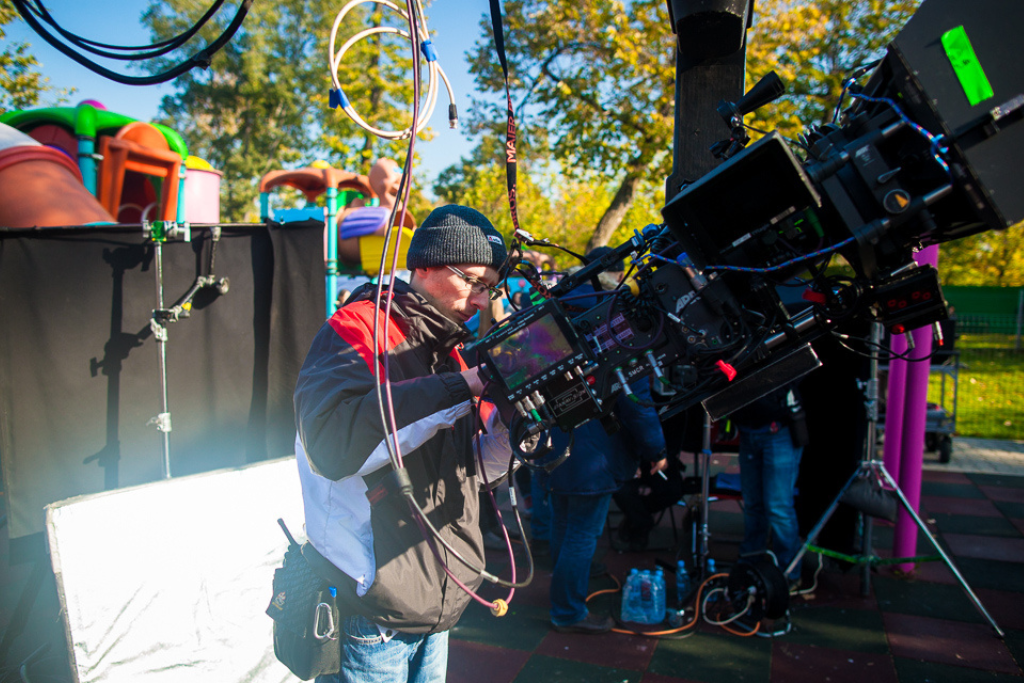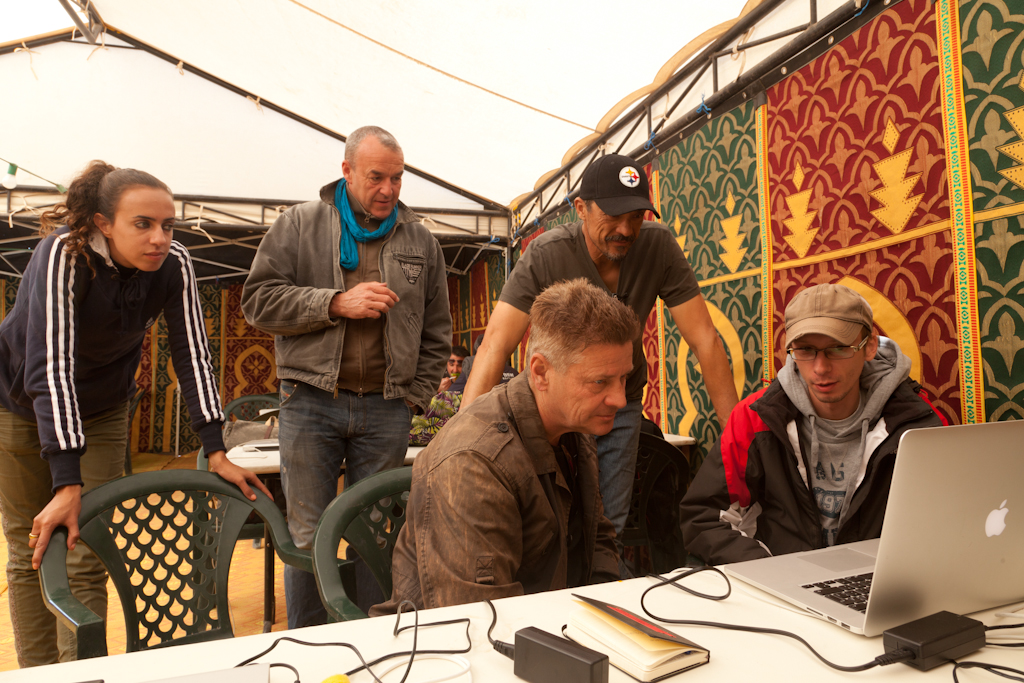
Hello and welcome! First of all, thank you so much for being here. Before we get into the specifics of your set-up, could you give us some background info on how you got your start and some of your past experiences in the industry?
Alexandru: I first started out doing data and DIT in 2010, when I joined the Kodak Cinelabs Romania team (now known only as Cinelabs Romania). Back then, Kodak was experimenting with transitioning to digital and this was the first lab to build a digital division, with DI and DIT. My first film was an action thriller starring Jean Claude Van Damme. I started doing data management at first, splitting duties with a colorist on set, and eased into doing color for dailies myself. I was part of the team until 2015, during which I’ve worked on an average of 3-4 films per year. That year, I went freelance and started working a bit more outside of Romania on my own, in Morocco, Greece, and the Netherlands. A year after that, my partner and I started a video production company, building on my experience in film and her extensive experience in journalism and communication. We kept DIT as a secondary line of business, and we even teamed up for DIT projects that needed stronger management that the average, working together on features in Thailand, Japan, Romania and Belgium. We’ve actually relocated to Belgium in 2021. Over the years, I’ve gotten to work on more than 30 feature films and many commercials, each with their own interesting specifics, with award-winning DPs, some of which I’ve remained friends over the years, and great camera crews.
What types of productions do you usually work on? What are the main ways in which they differ from each other?
Alexandru: I can’t really say that I’ve worked on a specific type of project, as I’ve done a mix of feature film and commercial work over the past 13 years. I can tell you what I HAVEN’T worked on much, and that is TV series, which I’ve only started doing recently. No particular reason, it’s just that I gravitated more towards the feature and commercial side. I would say that if I look at the past 13 years, my feature film work is more present in my mind than my commercial work, and I believe that this is exactly where the difference between the two fields lies. Features have a bigger scope and require more preparation, whereas most commercials are one-to-two-day shoots that, as far as I am concerned, usually ask more on the project management side than the creative. Features include sitting down with the DP and discussing the intention of the cinematography, setting looks for the whole show or for different segments, following those creative choices all throughout the pipeline, liaising with post-production houses and pretty much safeguarding the picture, from both a technical and a creative point of view, from prep until turnover to editorial. Not to mention insuring that production sleeps well at night knowing that everything is safely backed up and checked.
And a follow-up question to that, do you have a favorite type of production to work on?
Alexandru: I think my favorite productions to work on are 6-8 week feature shoots, because they’re long enough that you can really put in some good effort, but short enough that they don’t feel like a drag. I never really cared for the month-in-a-row mammoth shoots, as they tend to wear you down.
Now everyone has different preferences and a different cart/workstation set-up, could you tell me about yours?
Alexandru: Because I’ve worked on a wide variety of projects, in various capacities (employee, freelancer, one-person team or part of a larger DIT/Dailies team), my gear has differed significantly from one show to another. In recent years, as I’ve moved more towards video and documentary production, I’ve preferred to scale my setups up and down depending on the project I’m working on, by mixing what I own with kit rentals. So I am going to describe what I include in my kit when I prepare a feature. First and foremost, because most of the jobs that I’ve done were near-set data and color jobs, I always insure that I have a larger van or truck with AC to work out of. This is an absolute must for me, because it a) protects the gear and the footage, b) allows me to be mobile, and c) allows for the control the lighting conditions when color grading. For the past few projects, the gear inside was composed of a cart (I actually like the Adicams, because they offer good value for money and are more than enough for what I need), a Mac Studio, a Macbook Pro, an OLED grading monitor (either Flanders Scientific or Sony), and a color grading panel (I like the Blackmagic Micro a lot, but have also used Tangent panels for many years). For video I/O I use a mix of Blackmagic Ultrastudio 4K and Blackmagic Monitor/Recorder 3G, depending on the computer setup, and for power backup, I use APC and Eaton. I color grade in Davinci Resolve.
For those that may just be starting to build their cart/workstation, or are in the early stages of it, what are some pieces of equipment that you consider absolutely essential?
Alexandru: First of all, because the core of this job is the safe management of data, I would begin with a powerful computer and robust media management software. This is where Shotput Pro has helped me a lot, because when I started out, DIT was still in the early stages and there was a lot of testing of different programs, some more stable and user friendly than others. When I went freelance, the first thing I did was buy a copy of Shotput Pro 5, because for me it was the most stable, reliable and user-friendly program I could find. Since then, I’ve worked with other programs as well, depending on if I used my computers or rentals, but I always keep my go-to copy of Shotput on my computer. And speaking of computers, I’ve been Mac based ever since I’ve started. The next things I would include in an essential core kit would be a UPS system. Here, I try to find a good balance between weight and power. For smaller data jobs, with a lot of moving, I’ve used the APC Back-UPS, and for the cart I prefer Eaton rackable UPS’s. For dailies color grading, always go with a trackball panel. If only starting out, the Tangent ripple is a great start. It packs lightly and can easily be used on the go. And, of course, a good grading monitor. You can rent if you don’t want to invest a few thousand Euros from the beginning, just make sure it’s always calibrated.
Going along with the previous question, do you have any tips for beginners in the field? What’s something you wish you knew when you were first starting out?
Alexandru: Build good, honest and kind relationships with your collaborators, whether it’s producers, DPs or crew, know your equipment and software inside out and never stop learning and evolving.

Do you have any on-set stories you’d like to share?
Alexandru: There is a running joke on the internet about the 7 stages of film production being Wild Enthusiasm, Total Confusion, Utter Despair, Search for the Guilty, Persecution of the Innocent, Promotion of the Incompetent and Distribution of T-Shirts. While the joke itself is, of course, wildly exaggerated (sometimes there are no T-shirts), the general idea is that during the course of the production of a film there are many times when you, as a DIT, are in a situation where you will feel the heat. I’ve been there, and anyone who says they weren’t is lying.
You will feel the heat when a card with an action scene suddenly errors in the camera and becomes unreadable (The manufacturer fixed it). You will feel it when the camera loses power and another important shot gets corrupted, so you have to find a way to fix is and get the clip back (I did). Or when you get to work on another show for one night, at the same time as the one you’re on, because their main camera was set up completely wrong color-wise and they want to know if the footage can be saved or they have to reshoot (It was, they didn’t). Or when you receive unsuitable storage from production on a remote shoot and you have to work against the clock to back it all up (We did, and I also want to send a message that storage is something that production should never skimp on. You don’t always get to have people on set who know how to fix it.) As a DIT, if you are confident about what you do, if you are involved in the process and always keep your cool, you can enjoy the finer things that this field offers you, like a masterclass in natural lighting from and Academy Award-winning DP, the chance to see legendary directors and actors at work or the wonderful experience of beautiful new places and cultures.
Thank you, Alexandru! Your responses have been incredibly informative, and I know they will benefit those who are new to the field. Don’t forget to return next week for another interview with a data expert!